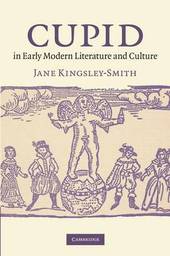
|
Cupid in Early Modern Literature and Culture
Paperback / softback
Main Details
| Title |
Cupid in Early Modern Literature and Culture
|
| Authors and Contributors |
By (author) Jane Kingsley-Smith
|
| Physical Properties |
| Format:Paperback / softback | | Pages:276 | | Dimensions(mm): Height 229,Width 152 |
|
| Category/Genre | Literary studies - c 1500 to c 1800 |
|---|
| ISBN/Barcode |
9781107654822
|
| Classifications | Dewey:820.9003 |
|---|
| Audience | | Professional & Vocational | |
|---|
| Illustrations |
9 Halftones, unspecified
|
|
Publishing Details |
| Publisher |
Cambridge University Press
|
| Imprint |
Cambridge University Press
|
| Publication Date |
19 September 2013 |
| Publication Country |
United Kingdom
|
Description
Cupid became a popular figure in the literary and visual culture of post-Reformation England. He served to articulate and debate the new Protestant theory of desire, inspiring a dark version of love tragedy in which Cupid kills. But he was also implicated in other controversies, as the object of idolatrous, Catholic worship and as an adversary to female rule: Elizabeth I's encounters with Cupid were a crucial feature of her image-construction and changed subtly throughout her reign. Covering a wide variety of material such as paintings, emblems and jewellery, but focusing mainly on poetry and drama, including works by Sidney, Shakespeare, Marlowe and Spenser, Kingsley-Smith illuminates the Protestant struggle to categorise and control desire and the ways in which Cupid disrupted this process. An original perspective on early modern desire, the book will appeal to anyone interested in the literature, drama, gender politics and art history of the English Renaissance.
Author Biography
Jane Kingsley-Smith is Senior Lecturer in the Department of English at Roehampton University and is a regular guest lecturer at Shakespeare's Globe. She is the author of Shakespeare's Drama of Exile (2003) and has also published on a range of topics including representations of Shakespeare in popular cinema, Elizabethan love tragedy and John Ford's 'Tis Pity She's a Whore.
Reviews"In sure-footed, economical prose the author moves back and forth between poetry, painting, and drama with great but not (we are grateful) dizzying speed." -DAVID SCOTT WILSON-OKAMURA,East Carolina University "It is a pity that it could not be more fully illustrated, since its historical survey includes the fascinating conflation, in the visual arts, of Venus and Cupid with Mary and Jesus." -- Studies in English Literature
|